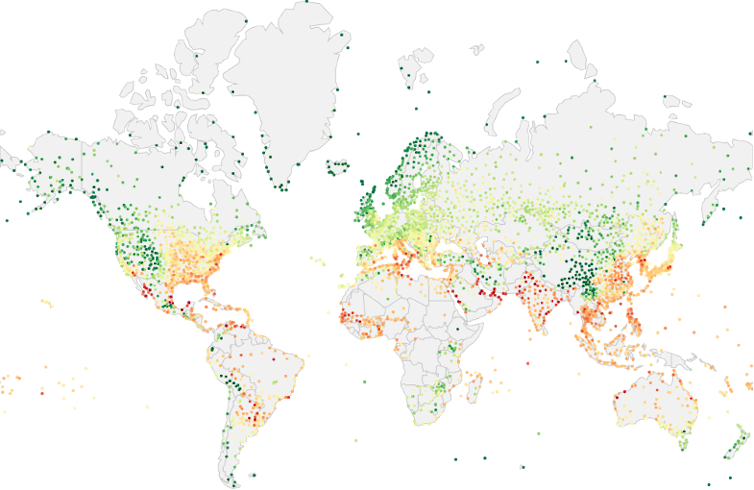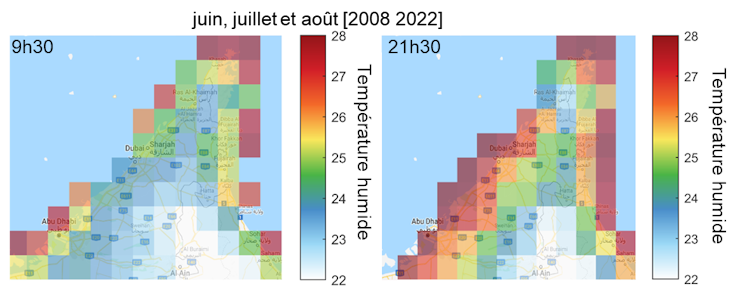This thermal index allows you to evaluate a feeling that is undoubtedly familiar to you: during heat spikes, when the temperature exceeds 35°C (95°F), we have all experienced a very different feeling depending on the humidity level: at the same temperature, dry heat remaining much more bearable than humid heat. Heat and humidity can even be a deadly combination, making life outdoors particularly unbearable.
While there are many ways to measure thermal comfort, particularly during heat waves, the term wet bulb temperature (WBT) is increasingly used by scientists and the media, for a simple reason: the closer it gets to the temperature of the human body, the more dangerous it becomes.
Why heat and humidity mean danger
Because when the humidity level is high, the sweating mechanism by which humans control their body temperature works much less well. The “critical” threshold of humid temperature for humans, that is to say the point from which a healthy person cannot hope to survive for more than six hours, was until recently considered to have been reached around 35°C (95°F) humid temperature. For example, this value is reached at an outside temperature of 35°C (95°F) and 100% humidity or even at 38°C (100.4°F) and 80% humidity. But very recent studies show that this fatal threshold would be much lower since it would be around 30-31°C (86-87.8°F) if the body cannot cool down quickly. Hyperthermia then sets in and brain and organ damage can appear, leading to other dangerous or even fatal consequences.
What the Olympics can teach us about humid weather
During the 2020 Olympic Games in Tokyo, to take into account the combined effect of heat and humidity on physical activities, humid temperature was used as an index to estimate the risk of heat-related pathologies. These latter games were in fact particularly high: considered the hottest in history, their participants indirectly inflicted conditions close to torture on themselves, with temperatures around 30-31°C (86-87.8°F) and a humidity level of 60%. However, the intense physical effort typically required during athletics events or outdoor team sports leads to muscle contractions releasing a considerable amount of heat and therefore a sharp increase in muscle temperature and core body temperature.
It is only subsequently that the heat produced is dissipated mainly in the form of perspiration. To give an order of magnitude: the feeling in terms of comfort or thermal stress was the same for a participant in the Olympic Games in Tokyo in 2021, as a football player at the World Cup in Qatar in 2022 (40°C (104°F) and 25% humidity).
Our past research has made it possible to map the regions of the world considered at risk from the dangerous temperature-humidity combination. But it is also a point of attention in our current research as part of the preparation for the Olympic Games which will take place in Paris this summer.
July is the hottest month of the year in Île-de-France. If the heat is exacerbated by stormy weather and/or high humidity, external conditions will be unbearable for competitions.
Local analyzes during one-off events, such as during the Paris Olympics this summer, will be useful to better understand and anticipate the impacts of the temperature-humidity combination on health. By combining athletes' medical data with local meteorological measurements, we should better estimate the impact of humid temperature on organisms subjected to intense efforts.
A story linked to military training
Collecting this kind of data is crucial, because as dangerous as they can be, the effects of humid temperature are still too poorly understood.
Historically, conditions associated with high humid temperatures were initially a subject of military study, as heat-related illnesses were a serious problem in the U.S. Army, Navy, and Marine Corps throughout the centuries. 1940s and 1950s. 200 deaths and several hundred illnesses due to heat were recorded between 1940 and 1953. Three years later, in 1956, in confidential documents from American Naval Research, now made public, the term wet temperature appears for the first time. Humid temperature has therefore proven to be a practical heat index for assessing heat stress on individuals active outdoors, and for predicting and quantifying heat illnesses. Its usefulness was quickly proven: despite warmer weather in 1956 in the United States, thanks to this new index, the incidence of heat-related illnesses was reduced by two thirds in the American army's naval troops.
But on a global scale, public interest in humid temperatures remains relatively recent. The chart below shows the percentage of Google searches for the phrase “wet bulb temperature” for the last 10 years worldwide. There has been a clear increase in searches in 2021, and this has been the case in every summer since.

Provided by the author
A temperature with different formulas
But exactly, how do we measure this famous humid temperature?
The tool used for this is in fact a thermometer whose mercury reservoir is contained in a damp cotton ball (or “bulb”) exposed to the air. At 100% humidity, the wet bulb temperature (here called wet bulb temperature) is equal to the air temperature (dry bulb temperature); at lower humidity, the wet bulb temperature is lower than the dry bulb temperature due to evaporative cooling.
This is the paradox and the difficulty of measuring the humid temperature: it certainly indicates a number in degrees Celsius lower than the dry temperature but a high level of humidity remains at the same time a great danger because our body perspiration which allows the body to cool itself by evaporation is jeopardized.
This type of wet bulb measurement, however, still remains rare because historically, weather report measurements did not include this data, because the very concept of wet bulb temperature is relatively recent, and because scientists calculate it indirectly.
A significant dispersion of geographical and historical observations
In recent years, research has been carried out on the evolution of humid temperature with climate change on a global scale. Researchers Tom Raymond and Colin Matthews, for example, examined temperature and humidity data from 7,000 weather stations around the world. They thus found that extreme humid temperatures are twice as frequent today as forty years ago.

Jeremy Hinsdale, Raymond et al., Provided by author
Although the number of meteorological stations used in this study (7,000) can be considered high, the stations are mainly located in developed countries and the distribution is not homogeneous across the globe.
We also note the lack of measuring stations in hot and/or humid countries (Africa, South America, the Arabian Peninsula and southern Asia), where the danger of high humid temperatures is particularly worrying.
Lack of knowledge about local processes at the city level
In the future, we should therefore be able to analyze the effects of humid temperature in a more homogeneous and targeted manner, particularly in countries in the South. However, the state of knowledge already makes it possible to identify certain aggravating effects.
he physiological effect of humid temperature is, for example, particularly intense in cities, which are generally urban heat islands, that is to say an area of temperature rise localized in an urban environment compared to neighboring rural areas. . Today, however, the physical links between humid temperature and urban heat islands remain poorly understood.
The humid temperature can also be particularly high in coastal cities such as those on the Persian Gulf (such as Dubai and Abu Dhabi), particularly in the evening, when the air is saturated with humidity. This illustration is an average, but daytime variability can include much higher wet temperature values.
Finally, we note that as we move away from the coast, the humid temperature decreases, while the ambient air temperature remains the same. When humidity is low (desert regions), so is humid temperature.

Complex diurnal variability
The animation below shows an example of the high daytime variability in wet temperature during the intense heatwave recorded in India in April 2022. To overcome the lack of local observations, and to create this animation, we are based on data from meteorological models called reanalyses. These bring together and assimilate several data sets (soils, satellites, planes, models, etc.) to create a product of sufficient quality.
Animation of wet temperature (WBT) by local time of the day on April 25, 2022.
Source: Sarah Safieddine (link in French)
Studies have shown that in the absence of significant measures that would make it possible to mitigate the rise in temperatures due to climate change, the survival threshold limit (= 31°C (87.8°F) or 35°C (95°F) depending on the different studies) will be reached and exceeded in the coming years, particularly in Africa, the Arabian Peninsula and South Asia. Here, for the case of India in 2022, we see for example that this threshold was exceeded for several hours during the day of April 25, 2022 (and for several hours a few days before and after). The humid temperature is unfortunately high in the regions which are also the most populated in the world.
For coastal cities, it’s a double whammy: they are hotter and more humid.
Humid weather is most intense on the coasts (higher humidity levels) and during the afternoon, when combined temperatures and humidity levels reach their maximum. We note that on the Indo-Pakistani border, close to the Indian Ocean, the humid temperature still remains dangerously high even at 6:30 p.m., the end of the working day.
A multidisciplinary field of research that is still largely unknown
We know that the human body's ability to withstand heat and humidity will not change as quickly as future climate disruptions. Climate projections from IPCC reports show that temperature increases will strongly depend on the speed with which greenhouse gas emissions decline. But climate projections of wet temperature are still subject to uncertainties, particularly at local scales when humidity measurements are not available. As a result, the societal and epidemiological effects are difficult to predict, and the measures to be taken in terms of territorial planning are complicated to implement.
Sarah Safieddine, Responsible for research CNRS (LATMOS/IPSL), Sorbonne Université et Cathy Clerbaux, Research Director CNRS (LATMOS/IPSL), invited professor from the Université libre de Bruxelles, Sorbonne Université
This article has been translated from The Conversation under a Creative Commons licence. Read the article in French.


